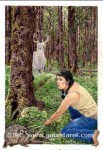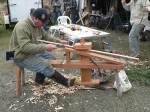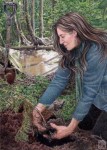![]() Article written by Dr. Thomas P. Chisholm, Col., USA, Ret.
Article written by Dr. Thomas P. Chisholm, Col., USA, Ret.
Identifying tracks of wild animals is easiest in new snow when the temperature is moderate on a sunny day. March is often the best month when the snow is deep and the weather is warmer. Tracking on skis is pleasant but snowshoes are best when the brush is thick under the trees and the balsams are dense. Both are good exercise, burn calories rapidly and the thrill of identifying a bobcat or a fox is an adventure.
Finding the large prints of an elusive wolf that end with at the remains of an elk is another thing. I found what as left of an elk not far from my primitive cabin on St. Patrick’s Day a few years ago. There were many poorly defined wolf and elk tracks around the carcass in the rust colored snow. Not much to identify an elk besides some fur, its spine and part of its head. The wolves, ravens and their forest friends had picked the carcass nearly clean. I looked for the bright orange collar and the number that the DNR biologists identify an elk when they capture them. I took off my snowshoes, kicked around with my feet, dug about with my ski poles for a few minutes looking for the collar gradually increasing the radius.
Looking up I noticed my familiar little green, lopsided outhouse, leaning in a drift. I quit searching, strapped on the snowshoes and headed for the firebrick red, wood-sided cabin, 50 yards toward the snow-covered lake. It took a few minutes to find the key and move enough snow from the door to enter the cold, musty interior with the barrel stove in the center.
I called the DNR in Hayward and left a message, filled the stove with paper and kindling and birch. In a few hours the cabin was warm, 68 F. Outside the sun drifted west through filmy clouds over the snow-covered lake disappearing in tall pines planted 40 years ago. I watched the silent starry sky that night then slept after a supper of canned soup and bottled water. I dreamed, a nightmare of dead GIs in the snow that frigid winter of 1950-51.[1]
In the morning, Laine Stowell, the chief DNR elk biologist called. He was parked at the boat landing a mile down the trail from the cabin and about to ride in on snowmobiles with his crew. They arrived in ten minutes, plunged through the snow and joined me at the remains of the carcass. “Yes, Doc, it was an elk. See the scats—wolves again.” The crew searched for a collar, found nothing, put the well-chewed head of the elk in a plastic bag and thanked me for reporting the kill. We “shot the bull” for a few minutes. “No Doc, we have coffee in the truck. It’s time to bug out. Thanks again.” They walked back to the snowmobiles, cranked up and buzzed through the rickety gate disappearing into the woods.
Wolf History & Lore
“Grandma, What big eyes you have!” said Little Red Riding Hood. And the wolf replied in a deep voice and sour breath, “The better to see you my dear.” That 17th century fable, Le Petit Chaperon Rouge, by the French author Charles Perrault was a lesson for young girls: do not trust smooth talking men.
Hey, hey, good looking’,Whatcha got cookin’? How’s about cookin’ somethin’ up with me?
Hey, sweet baby, Don’t you think maybe, we could find us a brand new recipe?
I got a hot rod Ford anna two dolla bill, I know a little spot right over the hill.
I’m free and I’m ready, Hows about keepin’ steady company? [2]
The other fable, “The Three Little Pigs”, warn that wolves are dangerous. They may eat us for lunch. The third pig built a brick home. I bought a cabin.
The old fairy tales and the fear of wolves came with European immigrants to Wisconsin. Strangely, the fear persists. Ancient grandfathers of modern dogs, those stealthy yellow eyes, bad breath and sharp teeth might get you if you “if you don’t watch out”. Jesus warned that wolves appear in sheep’s clothing, like false prophets. There are many and varied false prophets but they don’t wear sheepskin. They are mammals, bipeds and they prowl. They generate fear and loathing but they are not Canis lupus. The Wisconsin gray wolves are quadrupeds, elusive, and fearful of humans. I hear them occasionally, follow their tracks in snow but have seen only three wolves in more than fourscore years.
Wolves were nearly extinct in Wisconsin and elsewhere across the United States by 1930. From a population of more than 5000 in 1800, wolves disappeared like the buffalo. With the exception of Thoreau in the 19th century. There were few environmentalists that understood the value of wildlife and its importance to the balance of nature. Even Aldo Leopold, our first great Professor of Ecology in Madison did not initially grasp the relation of Canis lupus to all native animals on earth, particularly deer.[3]
As the forests disappeared and the environmental movement grew in response to widespread devastation of land, topsoil, habitat, water and all forms of flora and fauna, Professor Leopold, Theodore Roosevelt, John Muir, Gifford Pinchot, Sigurd Olson and many others organized and lobbied in new university Forestry Departments, in State Houses and in Congress for protection of natural areas, wilderness, lakes, rivers, prairies and cutover lands of aspen, birch and tamarack. Wolves and all large animals were finally protected.
Migrating from Minnesota and Michigan the population of wolves in northern Wisconsin increased through the last thirty years until reaching an estimated number of nearly 800 in 2012. Yet despite environmental education, wolves continued to threaten many across the United States, particularly farmers and hunters. They considered wolves voracious killers of deer, elk, domestic animals and humans. Nothing is further from the truth.
Wolves Return & Deer Populations Explode
Wisconsin deer populations have been studied since 1962. Despite yearly hunter  complaints there are more than sufficient deer to ensure a yearly harvest and a healthy herd. The recommended number is 700,000, considerably less than the current number of 1,800,000. During the 2012 gun season, 300,000 deer were killed. Wolves kill only 16,000 deer annually and 40,000 are killed on roads and highways. If the ratio of wolves to deer is 800/1,500,000 or (1/1875), it is clear that wolves do not play a significant role in decimating the deer population.
complaints there are more than sufficient deer to ensure a yearly harvest and a healthy herd. The recommended number is 700,000, considerably less than the current number of 1,800,000. During the 2012 gun season, 300,000 deer were killed. Wolves kill only 16,000 deer annually and 40,000 are killed on roads and highways. If the ratio of wolves to deer is 800/1,500,000 or (1/1875), it is clear that wolves do not play a significant role in decimating the deer population.
DNR biologists, forestry students and volunteers have studied wolves by since 1979 when there were just a few wolves in northern Wisconsin. The population increased rapidly in recent years following a marked decrease due to mange, (scabies), diseases, including Lyme disease, starvation and poaching. Wolves also die of wounds from the animals they attack.
Litters of 4-6 pups are born in spring but 40 percent die the first year. The most recent study of 2011-12 prior to the 2012 hunt reported 750 to 800 wolves. The wolves are live captured and radio collared. Their number and condition is recorded in the annual Timber Wolf Status Report. The data incudes numbers of healthy wolves, packs, locations, deaths, causes of deaths, predation of domestic animals, types of animals killed and financial compensation to livestock and animal owners.
Twenty-three actively monitored wolves died in 2011: 9 illegally killed; 7 hit by vehicles; 2 euthanized for human safety concerns; 1 killed by artillery practice at Ft. McCoy; 1 capture related; 1 mange; 1 disease. Eighty non-collared wolves died for similar reasons: 42 vehicle collisions, 24 illegally killed, 3 from inter wolf fights, 4 of unknown causes, 1 mange, 1 artillery fire, 1 capture related, 4 euthanized for safety reasons.
Wolves are strict carnivores, consuming predominately deer, their preferred diet, plus beaver and smaller animals. Their diet is 55% deer, 16% beaver, 10% rabbit, 19% mice and other small animals. They are capable of killing elk as indicated previously as well as moose and buffalo. Wolves kill to eat, to survive and to control—like us. They wean the deer and elk herds of aging, sick, injured and weaker stock. The strong survive, mate and produce healthy progeny.
Elk Reintroduction in the Heart of Wolf Country
My interest in Canis lupus began when elk were introduced in Sawyer County, Wisconsin near the old logging village of Clam Lake a few miles from property our family manages with the Forest Service and the Rocky Mountain Elk Foundation within The Chequamegon National Forest. Elk were native to Wisconsin but with the wolves, turkeys, passenger pigeons, pine martins, fishers and so many other wild animals they were hunted to extinction either for food or fear. In addition, habitat decreased with the invasion of farms, mines, trap lines, forest destruction, sawmills, bounties, homes, resorts, cottages and guns. Deer survived somehow and are thriving today despite predation, hunting, severe winters, disease and vehicular collisions.
Ninety-five elk were brought to the Clam Lake area in 1995 creating great interest in the experiment locally, throughout Wisconsin and attracting tourists hoping to see wild elk at home rather than in the Black Hills or the Rocky Mountains. Would they survive? The question increased my interest great enough to put my quarter section into a perpetual easement to prevent any further real estate development, secure it for my family and assist the elk program.
With the assistance of the elk biologists from UW-Stevens Point, the Forest Service and the DNR, a five-acre meadow was cut from the dense forest and planted with clover and alfalfa to provide forage and attract the elk away from the roads. It also provided a place to capture the elk in a corral and apply bright orange radio collars to constantly track their location, movement or lack of movement. The collars are applied during winter in cold weather.
Elk do not tolerate hyperthermia and the neuro-metabolic stress of the process. They are baited with fresh forage and fruit. The non-collared elk are cut from the herd and gingerly shoved into a narrow shoot where they are held tightly while the collars are applied. Successfully collared they are released and run rapidly to freedom. No serious injuries or deaths have occurred to the DNR personnel or the elk during the efforts.
Elk do not tolerate hot summer days, are nocturnal creatures and are best seen between sunset and sunrise. Elk are silent creatures until September, the rutting season, when the bulls bugle a high-pitched scream looking for the cows. Elk are omnivorous, silent creatures until September, rutting season, when the bulls claim their harems. Their high-pitched screams, the “bugle” is easy to hear in late September evenings even through the nights.
The elk herd is growing slowly, an average of 13 percent yearly, much less than the estimated 25 percent considered reasonable by the experts when the restoration plan was proposed. After 17 years of effort and study the population following calving in 2013 is predicted to reach 180. That is an optimistic forecast because February and March are months of deep snow and greatest predation by wolves.
Elk Predation by Wolves & Others
The signals from each collared elk reach the biologists and crews cruising daily over thousands of acres in an ever-enlarging radius from Clam Lake and my property. If the signal, two beats/second, indicates an animal is not moving, it means trouble, usually death. A stationary cow in the spring indicates calving. The area is swept with volunteers until the cow and the calf is found. The bright collar and the intensity of the signal help find the elk. Calves are usually quiet and can be blindfolded easily while a flexible collar is applied. Following the signal is one thing, searching through the forest over irregular terrain in winter or during hot summer days with flies and mosquitos is hard work.
In early spring, hibernating bears, generally omnivorous, awake thin and hungry. Bear killed two yearling elk in 2011. The estimated 2012, spring population is less than the elk lost since 1995, one hundred ninety-five (195). They succumb primarily to predators, and vehicle collisions in addition to rutting fights, liver flukes, parasites, other diseases, corn acidosis, starvation and poaching. The type of predator is generally easy to identity from eschatological evidence, scats. If a cause of death cannot be made, the carcass is conveyed to a veterinarian for an autopsy.
Predation is part of life and death in the forest. Wolves killed 3 elk in 2010, 9 during 2011 and 13 in 2012. Wolves account for 38 % of elk predation. There were no bear predations in 2012, a mild winter and early spring but bear usually kill at least two elk every year and account for 15 percent of elk predation.[4],[5] Hunters and farmers have been concerned with wolf predation and the slow increase in the elk population. When the elk project was designed, the DNR did not intend that elk would be protected in a park-like area. They expected the elk to survive, multiply and be hunted, with restrictions, when the population reached two hundred.
Pressure for a Wisconsin Wolf Hunt
Nevertheless, sentiment to protect both elk and wolves is strong in Wisconsin and against strong opposition, wolves were removed from endangered and protected status in early 2012.[6] In April 2012, Governor Walker eagerly signed legislation permitting wolf hunting and trapping. The WDNR designated a hunting season from mid October 2012 through February 2013. More than eleven hundred licenses were issued but the demand was far greater indicating the desire to kill wolves. 117 wolves were killed in just a few weeks, one more than the number allowed.
Following the hunt, a candle light ceremony was held on the steps of the Wisconsin State Capitol by protesting pro-wolf groups reading eulogies for the departed wolves. Wolf hunting in Minnesota was also vigorously opposed. Led by the International Wolf Center in Ely, Minnesota a moratorium on future wolf hunting was recently introduced in the Minnesota legislature with added support from the Howling For Wolves Society.[7]
Wolves also kill domestic cattle yearly. It is the cattle and dog predation that cause such vengeance toward wolves and perpetuate the myths and fairy tales of the wily wolf. Wolves killed 111 cattle on 33 farms in 2011. This includes 9 adult cattle, 59 calves, 9 sheep, 35 lambs, 11 goats, 1 horse and 2 chickens. Compensation returned to the farmers totaled $284,000. In addition, 4 pet dogs and 17 hunting dogs were killed at a cost of $44.000.[8]
Hunting bear with dogs is permitted in Wisconsin, the only state that allows it. The dogs are trained before the season begins in September and are exposed to wolves. Dogs are members of the same family, Canis lupus familiaris , a subspecies of the gray wolf, members of the Canidae family of the mammalian order Carnivora. Wolves, by their nature, attack and kill dogs particularly if their territory is invaded or their pups are with them. Rarely, packs of dogs kill wolves, but that is unusual with the exception of certain hunters in other states that are permitted to use dog packs to kill wolves.
Like most animals, wolves are afraid of humans. Why they are afraid is not known. It may be because humans are bipeds, stand up are vertical. Wolves never stand like bear. Perhaps they recognize us by scent, sight and sound–guns! Because there are relatively few wolves, are well camouflaged, nocturnal, reclusive, move silently and do not eat garbage like bears, we rarely see them.
Dave Mech, the widely recognized wolf expert and founder of the International Wolf Center at Ely, Minnesota is the best source for human/wolf interaction, injuries and related deaths.[10] However, human attacks are extremely rare. Direct confrontation with wolves should be avoided. Some deaths have occurred over the course of recorded history when a wolf was surprised in the wild, or had been habituated by persistent human contact that occurs when they are fed and lose their fear of humans.
Using the most recent numbers, the ratio of wolves to deer, 1.5/5697, is more than satisfactory. Deer are prolific. The ratio of wolves to the human population of 13 northern Wisconsin Counties is 700/241,000, about 1/700. There has never been a human life lost to a wolf in Wisconsin.[11] However the ratio of elk to wolves, 1/4, is unsatisfactory. The ratio of wolves to the population of livestock in Wisconsin is about 700/200,000.[12]
Conclusion: Wolves Must Be Protected
Only elk must be ”afraid of the big bad wolf” — and of bear, and soon, of humans. The elk population is rising, albeit slowly. I see elk often. Laine Stowell, the Chief Elk Biologist for more than 17 years, is more than cautiously optimistic. Meanwhile, I hunt with cameras, a small digital, and a trail camera. I have several photos of elk, not one image of a wolf — yet.
From this summary of four animal groups living in northern Wisconsin, one group, Homo sapiens, considered civilized, use guns not in self defense but to intentionally kill two of the other groups, deer and wolves, and intend to hunt the third group, elk, when their number increases to some arbitrary figure set by the DNR. This group hunt deer not just for food, but for sport. They kill wolves legally and illegally, not to eat, but for fir and fear.
Do the number of wolves relative to the percentage of domestic animals they kill in Wisconsin justify the persistent fear of The Big Bad Wolf ? Do the numbers of elk killed justify that fear? I am not afraid of wolves and I do not endorse hunting wolves. I intend to capture wolves only on my trail camera and share the photos, the track evidence, and my support with state biologists and our elected representatives. I encourage you to do the same.
Dr. Thomas P. Chisholm, father of Wolf College founder Chris Chisholm, was born and raised in the north woods of Wisconsin, where he now resides with his wife of 55 years, Nancy LeVasseur Chisholm, after service to community and country throughout the second half of the 20th century, from Korea to the Gulf.
Check out these excellent wildlife tracking opportunities in Washington State:
March & October: Saturday Wolf Tracker Trainings in Western Washington with the Wolf College.
July: Five Day Wolves & Wildlife Trackers Training in Western Washington with the Wolf College.
[1] Halberstam, David. The Coldest Winter, 2007. Hyperion,
[2] Wiliams, Hank. “Hey Good Looking1951
[3] Leopold, Aldo, A Sand CountyAlmanac & Other Writings on Ecology and Conservation. Curt Meine editor. 2013, The Library of America. NY pp 114-115.
[4] Stowell, Laine, Elk Mortality 1995-2013. Spread Sheet. E-mail 3/1/2013.
[5] Stowell, Laine. Personal communication, 3/3/2013.
[6] The pine marten is the only remaining protected wild animal. Emily Stone 3/08/13, www.cablemuseum.org
[7] www.howlingwolf society
www.defenders.org
[8] Weydeven, Adrian et al. Wisconsin Endangered Resources Report #141. Status of Timber Wolf in Wisconsin 7/11-6/30 2012.
[9] Adrian Weydeven, Personal communication, February 2013.
[10] www.wolf.org Dave Mech
[11] www/us-places.com/Wisconsin/population-by-County.htm Accessed February, 2013










